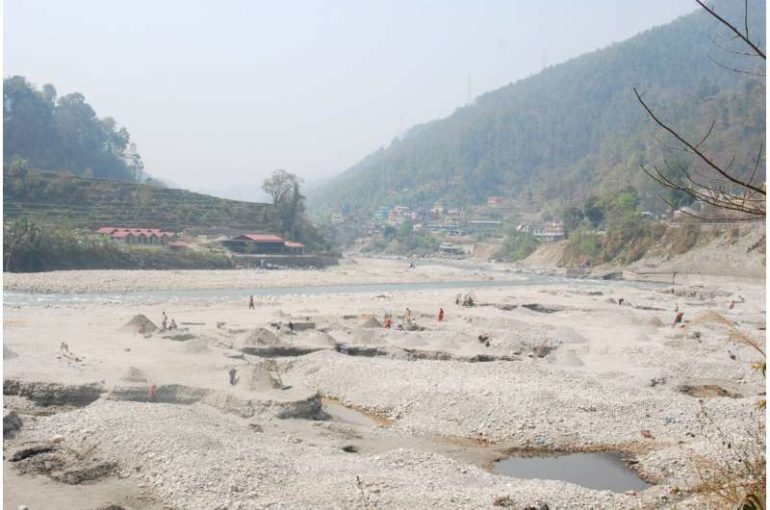Over 20 Indonesian islands mysteriously disappear. One of the world’s deadliest criminal syndicates rises to power. Eight cities the size of New York will be built every year for the next three decades. What connects them is sand, embedded in the concrete of nearly all of the world’s buildings, roads, and cities, the glass in the windows, laptops and phone screens, and COVID-19 vaccine vials.
The unexamined true costs of sand—broadly, construction aggregates production—has spurred a group of scientists to call for a stronger focus on understanding the physical dimension of sand use and extraction. They also suggest new ways to achieve economic and environmental justice.
Four years ago, an international group of scientists, including two from Michigan State University (MSU), called attention to a looming global sand crisis. Extraction of valuable resources across the planet typically brings to mind oil, coal or rare earth minerals. Construction aggregates—sand, gravel and crushed rock—can seem less rare by comparison. It’s easy, after all, to find a vast sandy beach, gravel pit or local hard rock quarry. However, construction aggregates are critical for meeting society’s needs for housing, health, energy, transportation, and industry.
In Science Magazine in September 2017, the group noted that overexploitation of sand, a key ingredient of concrete, asphalt and glass, was damaging the environment, endangering communities, and triggering social conflicts.
In this week’s One Earth, scientists led by research associate Aurora Torres shine a new light on the sustainability implications of the world’s hunger for sand and propose different solutions for meeting these challenges.
“With this paper, we look forward towards what we need to do as a society if we want to promote a sustainable consumption on global sand resources,” said Torres, part of MSU’s Center for Systems Integration and Sustainability (CSIS) and the Université catholique de Louvain in Belgium. “A drastic problem calls for drastic solutions—truly doing this differently to put aside problems and create pathways to sustainability.”
The authors of “Sustainability of the global sand system in the Anthropocene” call for a new way of looking at and understanding the interlinkages of sand supply and demand to reduce negative impacts such as depleting natural environments and creating human conflict. Collaborating across the research disciplines made it possible to fit the puzzle pieces into a full picture. Rather than focusing on single sand extraction sites like many studies before them, they take a broad look at the physical and socio-environmental dimensions of sand supply networks—linking extraction, processing, distribution, economics, policy—to gain an in-depth understanding of the stresses on both nature and people.
The novelty of the sand supply network approach is the integration of material flow analysis with the telecoupling framework to provide a more robust and holistic perspective on the sand system across different spatio-temporal scales. It allows for understanding and quantifying socioeconomic and environmental interactions from mining sites to consumption sites, such as cities, and spillover systems such as the transport corridors or rural landfills where the mining and construction waste piles up.
“Simple views cannot solve complex sustainability challenges,” said co-author Jianguo “Jack” Liu, director of MSU-CSIS. “New ways like the telecoupling framework help untangle and embrace the complexity of global sand challenges and point the way toward effective solutions.”
In addition, the authors highlight that robust strategies for managing sand resources depend on a solid understanding of the construction aggregates cycle. As Mark Simoni from the Geological Survey of Norway put it, “the physical system is key for linking local impacts of natural resource extraction to global development trends—we have to map how construction material demand and supply evolve over space and time to inform stakeholder decisions and policymaking.”
This requires quantifying the geological deposits, flows, and accumulation of construction aggregates within a region, including both natural raw material sources and alternatives, and it can be used to assess how long resources will last and how the entire supply system can be optimized to reduce negative impacts of sand mining and make use of substitute materials.
For example, they said, we need to think about construction aggregates beyond excavating deposits of sand and gravel. Blasting and crushing rocks also produces ‘artificial’ sand and gravel of similar or even higher quality and is a major export commodity for instance for Norway. Indeed, crushed rock has already become the main source of aggregates in countries like the U.S., China or in Europe.
With demand for construction aggregates predicted to double in the next decades, the sustainability challenge is daunting. Understanding how sand-supply networks work is relevant not only for assessing their full impacts but also for identifying leverage points for sustainability.
“As with climate change, there is not a single solution but multiple entry points for more sustainable consumption,” Torres said. Possible pathways include reducing material demand per capita, promoting compact urban development for more efficient material use, reducing reliance on natural deposits by developing the market and technologies for secondary materials such as construction and demolition waste, and when mining natural deposits is necessary, identifying the mining sources and production methods that minimize impacts for nature and people.
Tracing the source of illicit sand—can it be done?
More information:
One Earth, DOI: 10.1016/j.oneear.2021.04.011
Provided by
Michigan State University
Citation:
Sand’s urban role demands key part on sustainability stage (2021, May 21)
retrieved 23 May 2021
from https://phys.org/news/2021-05-sand-urban-role-demands-key.html
This document is subject to copyright. Apart from any fair dealing for the purpose of private study or research, no
part may be reproduced without the written permission. The content is provided for information purposes only.



